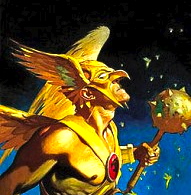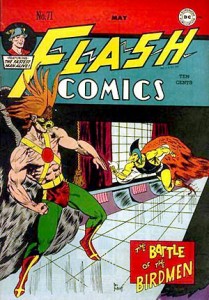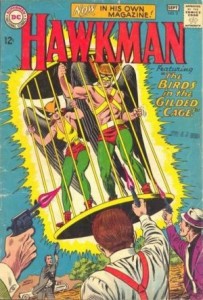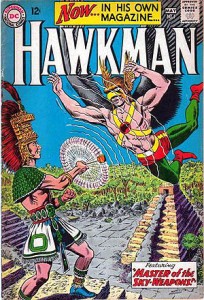Hawkman

Hawkman & Hawkgirl The Animated Series
Finally, my first true animation after college. This is another fan animation, this time of the DC Comics superheroes Hawkman & Hawkgirl! In this video is MY interpretation of their origin story, mixing the best of the Silver Age with a little of Golden Age. Make no mistake: this is Katar and Shayera and they are coming to our world to stop a renegade Thanagarian from wreaking havoc. Enjoy this rough sketch on the Hawks’ origin. Animated by: Carlos G. (Me) Music used: “Virtuous Mission” from Metal Gear Solid 3. Dunno about you, but I think I took some cures from the new Man of Steel movie with all the action and pacing. Speaking of which, what did you guys think of Man of Steel? Is it worthy to bring in the DC superheroes to our modern society. By: DC Comics Fan.
 Carter Hall as Hawkman Hawkman (vol. 4) # 1 Cover art by Andrew Robinson
Carter Hall as Hawkman Hawkman (vol. 4) # 1 Cover art by Andrew Robinson
Hawkman is a fictional character, a superhero who appears in comic bookspublished by DC Comics. Created by writer Gardner Fox and artist Dennis Neville, the original Hawkman first appeared in Flash Comics #1, published by All-American Publications in 1940.
Several incarnations of Hawkman have appeared in DC Comics, all of them characterized by the use of archaic weaponry and by large, artificial wings, attached to a harness made from the special Nth metal that allows flight. Most incarnations of Hawkman work closely with a partner/romantic interest named Hawkgirl orHawkwoman.
Since DC’s continuity was rewritten in the 1985 series Crisis on Infinite Earths, Hawkman’s history has become muddled with several new versions of the character appearing throughout the years, some associated with ancient Egypt and some with the fictional planet Thanagar. These versions of the character have starred in several series of various durations.
Hawkman first appeared in Flash Comics #1 (1940), and was a featured character in that title throughout the 1940’s. This Hawkman was Carter Hall, a reincarnation of an ancient Egyptian prince, Khufu, who had in the modern day discovered that the mysterious “ninth metal” could negate the effects of gravity and allow him to fly. He donned a costume with large wings to allow him to control his flight and became the crimefighter, Hawkman. He also had a companion hawk named Big Red that assisted him in fighting crime. An archaeologist by trade, Hall uses ancient weapons from the museum of which he was curator in his efforts.
 The Golden Age Hawkman, from Flash Comics # 71 (May 1946). Art by Joe Kubert.
The Golden Age Hawkman, from Flash Comics # 71 (May 1946). Art by Joe Kubert.
Hawkman was a charter member of the Justice Society of America, beginning with All Star Comics #3 (Winter 1940). In issue #8 he became the JSA’s chairman, a position he would hold until the end of the JSA’s run in All Star Comics. He was the only member of the JSA to appear in every adventure during the Golden Age of Comic Books. He romanced his reincarnated bride, Shiera Sanders, who became the crimefighter Hawkgirl. His first three adventures were drawn by creator Dennis Neville (who modeled Hawkman’s costume on the hawkmen characters in the Flash Gordon comic strip by Alex Raymond), then by Sheldon Moldoff, and later byJoe Kubert, who slightly redesigned his mask inFlash Comics # 85 (Jul 1947) and then, one year later, replaced the winged-hawk-like mask by a much simpler yellow cowl in Flash Comics #98 (Aug 1948).
Along with most other superheroes, Hawkman’s Golden Age adventures came to an end when the industry turned away from the genre in the early 1950’s. His last appearance was in All Star Comics #57 (1951).
Later in the decade, DC Comics under editor Julius Schwartz decided to revive a number of heroes in new incarnations, but with the same names and powers. Following the success of the Flash, Hawkman was revived in The Brave and the Bold # 34 (Feb-Mar 1961), this time as an alien policeman from the planet Thanagar, though his powers were largely the same. Created by Gardner Fox and Joe Kubert, this Hawkman, Katar Hol, came to Earth with his wife Shayera in pursuit of a criminal, and remained to fight crime on Earth. They adopted the names Carter and Shiera Hall and became curators of a museum in Midway City.
This Hawkman became a member of the Justice League of America, where he often verbally sparred with the iconoclastic liberal hero Green Arrow. In the 1960’s it was revealed that the original Hawkman lived on the parallel world of Earth-Two, and that Katar Hol lived on Earth-One. The JLA and JSA had an annual meeting throughout the 1960’s and 1970’s during which the two heroes often met.
 The Silver Age Hawkman and Hawkgirl, from Hawkman # 3 (August–September 1964). Art by Murphy Anderson.
The Silver Age Hawkman and Hawkgirl, from Hawkman # 3 (August–September 1964). Art by Murphy Anderson.
The Silver Age Hawkman had his own series for a few years, but with declining sales it was merged with that of the Atom. Atom and Hawkman lasted only another year or so before cancellation.
In the late 1970’s in Showcase and World’s Finest Comics, Thanagar went to war with the planetRann, the adopted home of Adam Strange. This led to Hawkman and Hawkwoman severing ties with their homeworld, and later fighting The Shadow War of Hawkman (written by Tony Isabella) as Thanagar tried secretly to conquer the Earth.
The landmark 1985 series Crisis on Infinite Earths resulted in a massive revision of much DC continuity and led to many characters being substantially rewritten. Hawkman was to suffer some of the greatest confusion as successive writers sought to explain his various appearances. In the revised timeline there was a single Earth which had witnessed the JSA in the 1940s and the JLA decades later. Successive revisions sought to establish exactly who had been Hawkman and Hawkwoman at different stages. For the first few years the pre-Crisis incarnations were still used, during which time they were prominent across the DC Universe and joined the latest incarnation of the Justice League.
Then DC decided to reboot Hawkman, in a limited series (which later led to an ongoing series) entitled Hawkworld originally by Tim Truman, and later John Ostrander. In this series, Thanagar was a class society which conquered other worlds to enrich itself. Katar Hol was the son of a prominent official who rebelled against the status quo. He and his partner Shayera were sent to Earth and remained there for some years until Hol was apparently killed.
This created a host of continuity errors as the new Katar Hol was established as having only just arrived on Earth, raising the question as to who had been around previously. In an attempt to resolve the problem it was established through retcons that the Golden Age Hawkman and Hawkgirl had also operated throughout the 1940’s up to the 1990’s, and that Nth metal came from Thanagar. They had remained active and then joined the original incarnation of the JLA. Moreover, yet another Hawkman – Fel Andar, a Thanagarian agent – had been the one who joined the Justice League during the 1980’s, pretending to be a hero but secretly seeking to infiltrate it.
The Zero Hour mini-series muddied the waters further by merging the different Hawkmen into a “Hawkgod”, who was the focus character in the third volume of the monthly Hawkman series. This version of Hawkman also had a small role in the alternate-future series Kingdom Come. After the demise of this series, Hawkman’s continuity was considered by DC to be too complicated, and he was absent from comics for several years.
In the late 1990’s, the JSA series untangled Hawkman’s continuity, establishing him as Carter Hall, a man who – along with Shiera – had been reincarnated dozens of times since his life in ancient Egypt, and whose powers were derived from Thanagarian Nth metal, which had been retroactively renamed from “ninth metal”. The Katar Hol of the Hawkworld series had also come to Earth during the 1990’s, as previously established. The 1980’s Hawkman Fel Ander went back to Thanagar. The Hawkgod was later revealed to be the avatar of the Hawk aspect of the Red from which Animal Man receives his powers and merely thought that he was Hawkman.
Also during the Identity Crisis miniseries it was established that Carter Hall had voted for the mindwipe of Dr. Light (indeed, he had been the one to initially suggest the idea) and it is from this that part of his enmity with Green Arrow stemed (as Green Arrow felt mental reprogramming beyond the scope of any vigilante group’s rights, and, in fact, those of any government).
With this new continuity, Hawkman was again reincarnated and given a new series in 2002 entitled Hawkman Volume 4, written initially by James Robinson and Geoff Johns, with art by Rags Morales. Justin Gray and Jimmy Palmiotti took over writing duties during the third year of the series. In 2006, the series was retitled Hawkgirl with issue #50 and given a new creative team Walter Simonson and Howard Chaykin. This series was cancelled with Hawkgirl issue #66 in July 2007.
Hawkman was a major character in the Rann-Thanagar War miniseries, which stemmed from events in Countdown to Infinite Crisis. During this time his continuity was further changed (See Carter Hall section below).


